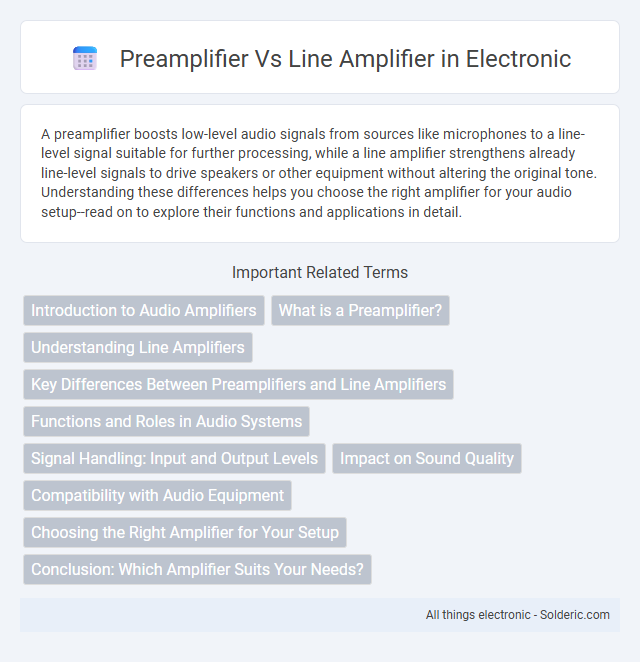A preamplifier boosts low-level audio signals from sources like microphones to a line-level signal suitable for further processing, while a line amplifier strengthens already line-level signals to drive speakers or other equipment without altering the original tone. Understanding these differences helps you choose the right amplifier for your audio setup--read on to explore their functions and applications in detail.
Comparison Table
| Feature | Preamplifier | Line Amplifier |
|---|---|---|
| Purpose | Boosts weak audio signals to line level | Amplifies line-level signals without changing signal characteristics |
| Input Signal | Low-level input (e.g., microphone, instrument) | Line-level input (e.g., CD player, mixer output) |
| Output Signal | Line-level output for further amplification | Enhanced line-level output, typically driving long cables or multiple devices |
| Gain | High gain (typically 20-60 dB) | Moderate gain or unity gain (0-20 dB) |
| Noise Performance | Low noise design to preserve weak signals | Minimal noise addition, focused on signal fidelity |
| Common Usage | Microphone inputs, instrument pickups | Signal distribution, cable driving |
| Frequency Response | Wide bandwidth to maintain signal accuracy | Flat response for line-level audio signals |
Introduction to Audio Amplifiers
Audio amplifiers are essential devices that boost audio signals to drive loudspeakers, with preamplifiers and line amplifiers serving distinct roles. Preamplifiers amplify low-level signals from sources such as microphones or turntables, preparing them for further processing, while line amplifiers strengthen already amplified signals to transmit them across audio systems without degradation. Understanding the differences between preamplifiers and line amplifiers is crucial for optimizing audio signal quality and ensuring proper system integration.
What is a Preamplifier?
A preamplifier is an electronic device designed to amplify weak audio signals from sources like microphones or turntables to a level suitable for further processing by a power amplifier. It provides essential functions such as gain control, impedance matching, and noise reduction to ensure signal clarity and fidelity. Unlike line amplifiers, preamplifiers handle low-level signals and enhance audio quality before the main amplification stage.
Understanding Line Amplifiers
Line amplifiers boost audio signals to a consistent level over long cable runs, minimizing signal loss and preserving sound quality in home theater or professional audio systems. Unlike preamplifiers that adjust input levels and tone, line amplifiers focus solely on amplifying the line-level signals without altering the audio's characteristics. Understanding line amplifiers helps you maintain clear and powerful sound in setups requiring extended cable distances.
Key Differences Between Preamplifiers and Line Amplifiers
Preamplifiers amplify low-level audio signals from microphones or instruments to line level, providing initial gain and noise reduction, while line amplifiers boost already line-level signals without altering tone or adding noise. Preamplifiers often include tone controls and impedance matching features, whereas line amplifiers focus on clean amplification with minimal distortion. The primary difference lies in the signal level processing stage, with preamplifiers designed for raw input signals and line amplifiers for signal distribution or level adjustment.
Functions and Roles in Audio Systems
Preamplifiers boost weak audio signals from sources like microphones or instruments to a line-level signal suitable for further processing. Line amplifiers, also known as line drivers, maintain signal strength over long cable runs without adding gain or distortion. Both play critical roles in preserving audio signal integrity and ensuring optimal sound quality throughout an audio system.
Signal Handling: Input and Output Levels
Preamplifiers handle low-level input signals from sources like microphones or turntables, boosting them to line level with minimal noise and distortion for further processing. Line amplifiers manage signals already at line level, providing consistent gain and impedance matching without significantly altering the signal's quality or dynamics. Your choice depends on the signal source and intended signal level adjustments to preserve audio fidelity.
Impact on Sound Quality
Preamplifiers significantly enhance sound quality by amplifying weak audio signals with minimal noise, preserving detail and dynamic range before further processing. Line amplifiers primarily boost signal strength for transmission, often contributing less to tonal color but increasing signal clarity and volume without distortion. Choosing the right amplifier depends on the audio system's need for clean gain versus signal boosting, impacting overall sonic fidelity and listening experience.
Compatibility with Audio Equipment
Preamplifiers are designed to boost low-level signals from sources like microphones or turntables to line level, ensuring compatibility with various audio equipment that requires a standard input level. Line amplifiers, however, are intended to amplify line-level signals without altering the original sound quality, making them ideal for connecting multiple audio components such as mixers, processors, or receivers. Your choice depends on the type of audio source and the needed signal strength to maintain optimal compatibility with your existing audio system.
Choosing the Right Amplifier for Your Setup
Choosing the right amplifier for your setup depends on the signal level and purpose of amplification. A preamplifier boosts weak audio or instrument signals to line level, making it essential for microphones and turntables, while a line amplifier further amplifies line-level signals to drive speakers or mixers without adding noise. Understanding these roles helps you optimize sound quality and maintain signal integrity in your audio system.
Conclusion: Which Amplifier Suits Your Needs?
Choosing between a preamplifier and a line amplifier depends on audio system requirements; preamplifiers enhance weak signals from sources like microphones or guitars by providing initial gain, while line amplifiers primarily boost line-level signals without altering tone. For high-fidelity sound systems demanding precise signal conditioning, a preamplifier suits best, whereas line amplifiers are ideal for maintaining signal strength across long cable runs or multiple devices. Evaluating signal source strength, desired tone control, and system complexity helps determine the optimal amplifier type for your setup.
Preamplifier vs Line amplifier Infographic

 solderic.com
solderic.com